
Chinese Journal of Applied Chemistry ›› 2025, Vol. 42 ›› Issue (2): 182-191.DOI: 10.19894/j.issn.1000-0518.240391
• Full Papers • Previous Articles Next Articles
Preparation of Gold Nanorod Self-Assembled Flexible Films and Ratiometric Surface-Enhanced Raman Scattering Detection of Bacteria
Lu-Lu TIAN1, Song-Tao HU2, Xu-Zhou QU2, Lin WANG1( ), Biao DONG2(
), Biao DONG2( )
)
- 1.Department of Oral Implantology,School and Hospital of Stomatology,Jilin University,Changchun 130012,China
2.State Key Laboratory on Integrated Optoelectronics,College of Electronic Science and Engineering,Jilin University,Changchun 130012,China
-
Received:2024-11-28Accepted:2025-01-08Published:2025-02-01Online:2025-03-14 -
Contact:Lin WANG,Biao DONG -
About author:dongb@jlu.edu.cn
wanglin1982@jlu.edu.cn;
-
Supported by:the National Natural Science Foundation of China (No.?52272080) and the Natural Science Foundation of Jilin Province(20220402005GH)
CLC Number:
Cite this article
Lu-Lu TIAN, Song-Tao HU, Xu-Zhou QU, Lin WANG, Biao DONG. Preparation of Gold Nanorod Self-Assembled Flexible Films and Ratiometric Surface-Enhanced Raman Scattering Detection of Bacteria[J]. Chinese Journal of Applied Chemistry, 2025, 42(2): 182-191.
share this article
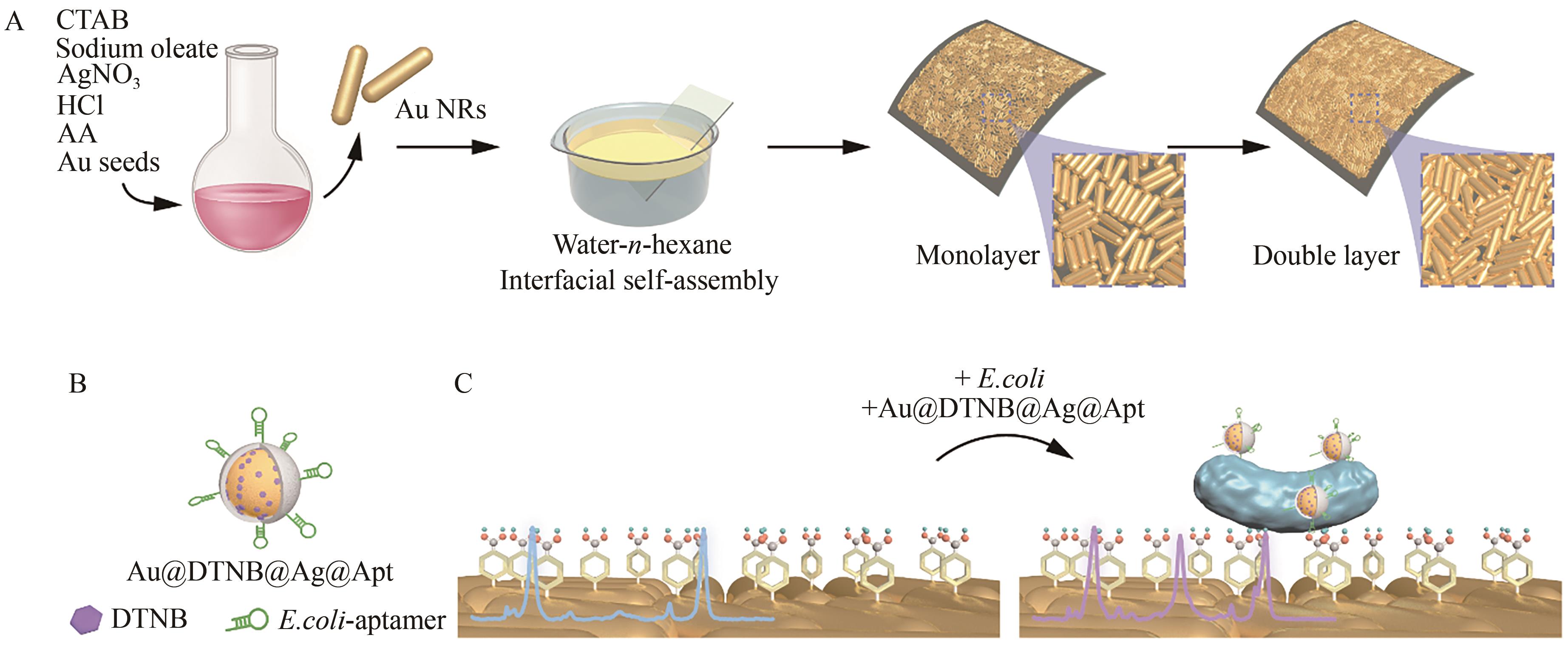
Fig.1 (A) Schematic diagram of the assembly and structure of the Au Film; (B) The structure of Au@DTNB@Ag@Apt; (C) The detection mechanism of Au Film@MPBA and Au@DTNB@Ag@Apt to E.coli by the sandwich recognition method
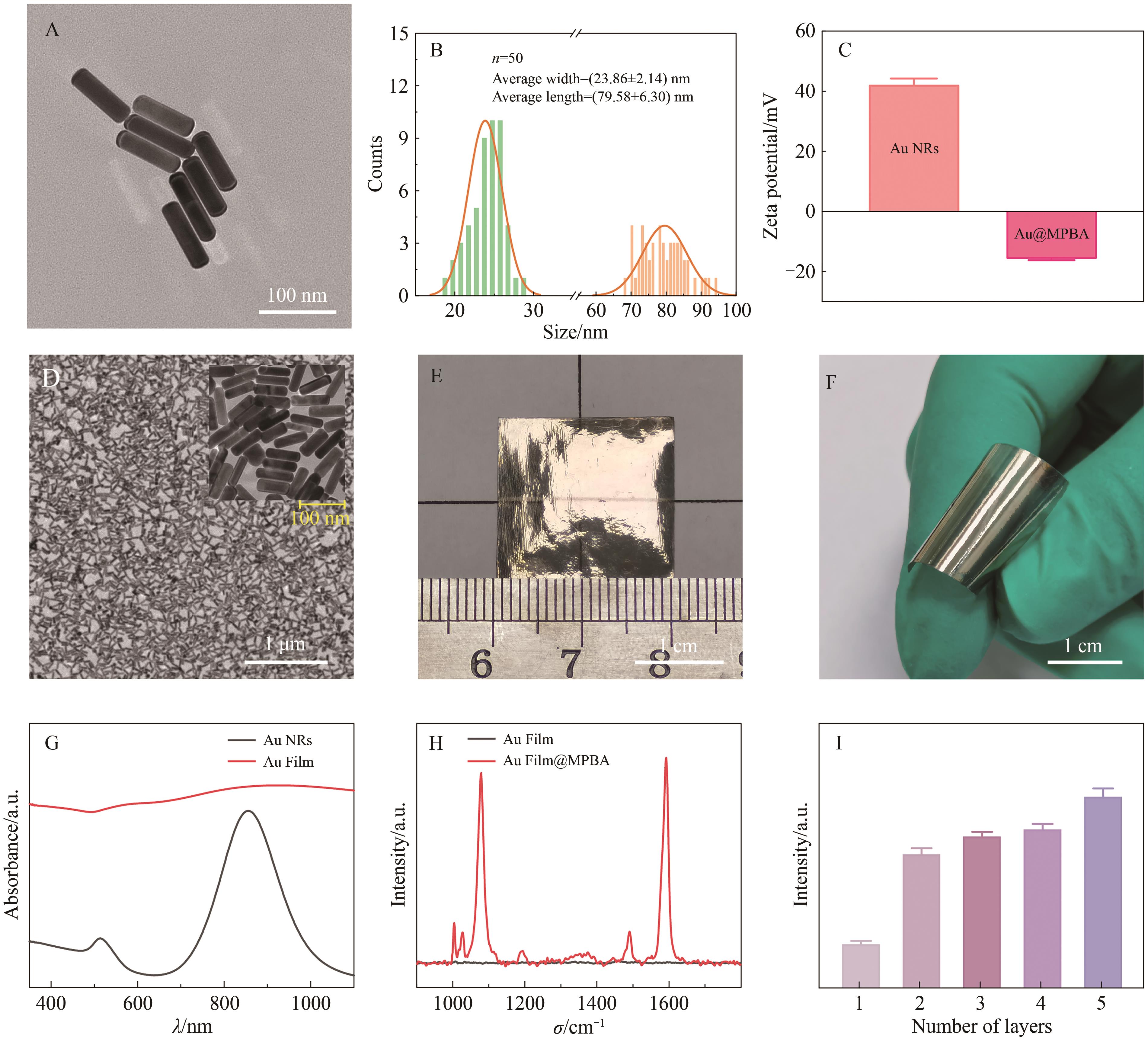
Fig.2 (A) TEM image and (B) length and diameter statistical data of Au NRs; (C) Zeta potential of Au NRs and Au@MPBA; (D) TEM image, (E) physical dimensions, and (F) texture of Au Film; (G) UV-Vis spectra of Au NRs and Au Film; (H) Raman spectra of Au Film and Au Film@MPBA; (I) SERS activity of Au Film@MPBA with different layers
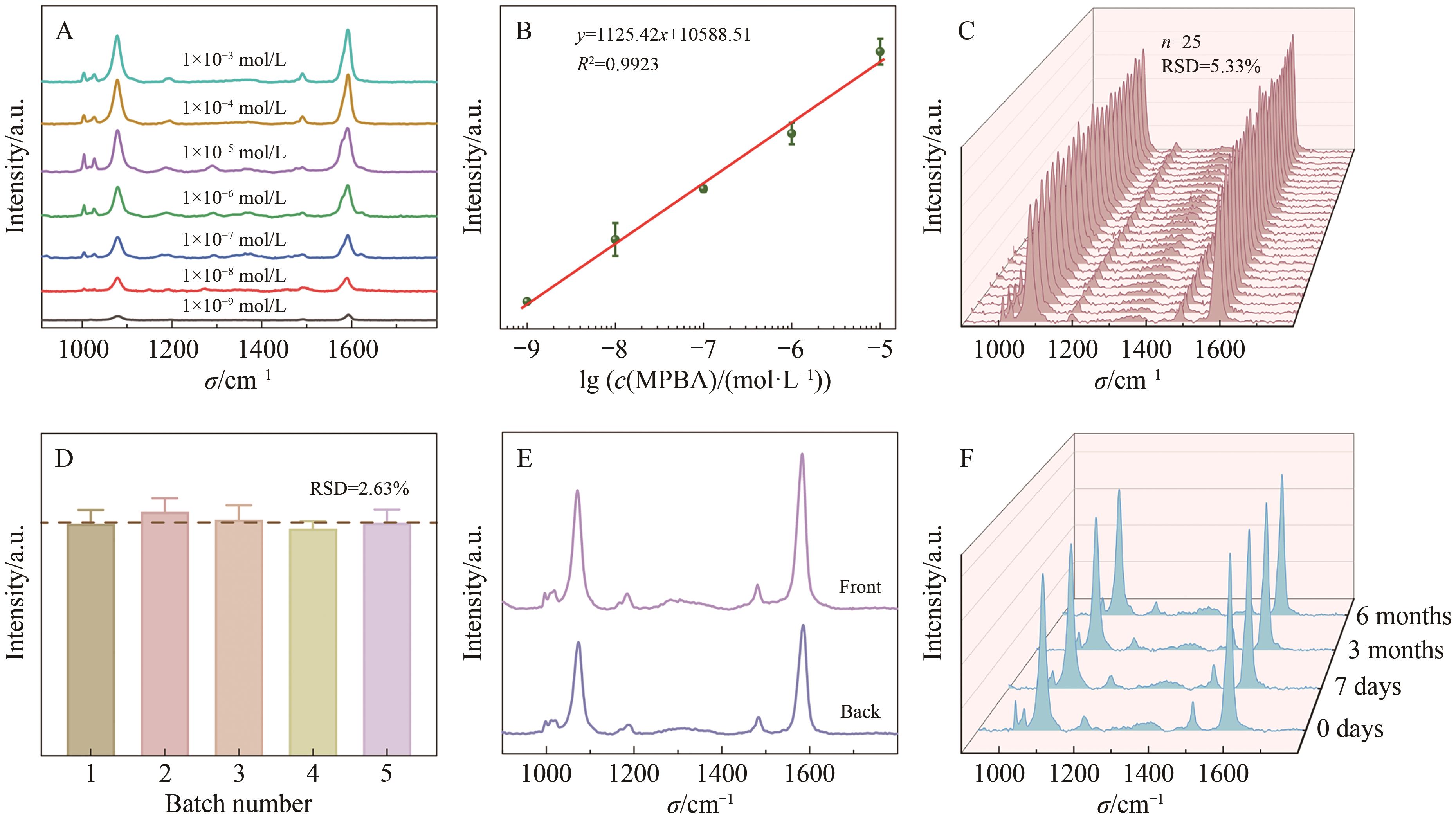
Fig.3 (A) SERS results and (B) linear fitting curve of the Au Film with different concentrations of MPBA; (C) SERS activity at different sites on Au Film@MPBA; (D) SERS activity of different batches of Au Film@MPBA; (E) SERS results collected from the front and back of Au Film@MPBA; (F) SERS performance of Au Film@MPBA after storage for 0 d, 7 d, 3 months, and 6 months
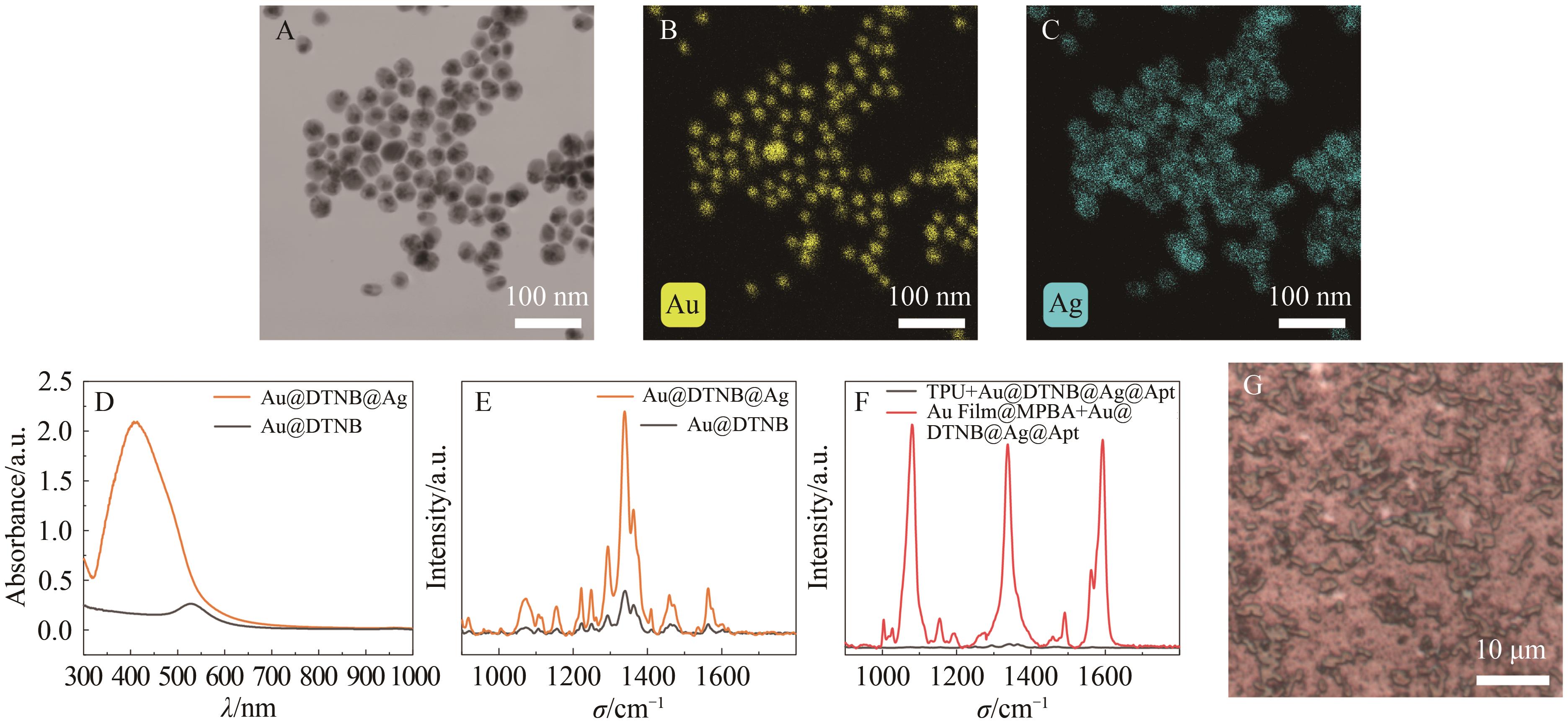
Fig.4 (A) TEM image of Au@DTNB@Ag; Elemental distribution of (B) Au and (C) Ag of Au@DTNB@Ag; (D) UV-Vis spectra of Au@DTNB and Au@DTNB@Ag; (E) SERS activity of Au@DTNB and Au@DTNB@Ag; (F) Raman enhancement of blank TPU and Au Film@MPBA to Au@DTNB@Ag; (G) Optical microscopy image of Au Film@MPBA capturing E.coli
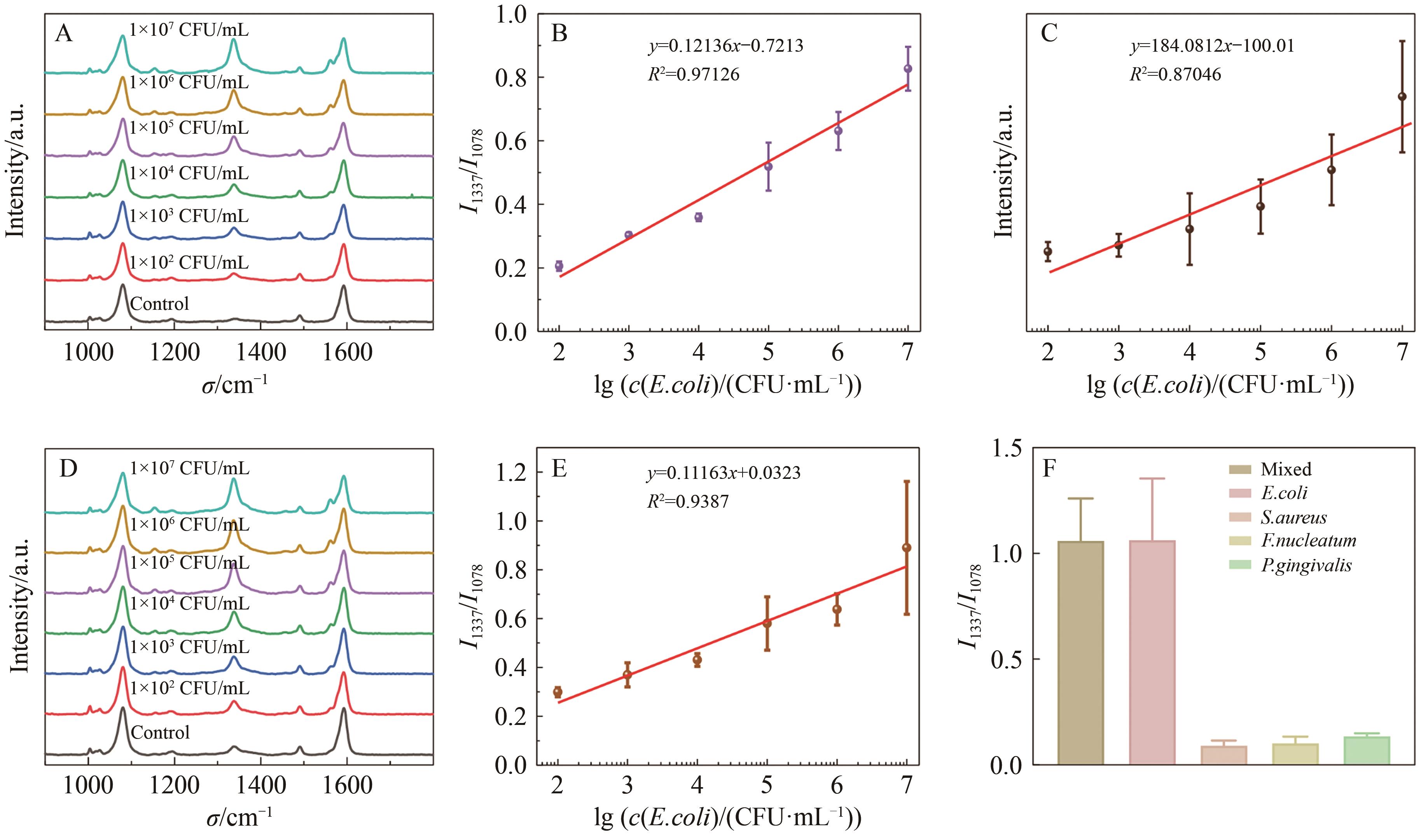
Fig.5 (A) SERS results of sandwich-like substrates at different E.coli concentrations (0~1×107 CFU/mL) in water; The relationship (B) between the logarithmic concentration of E.coli and I1337/I1078 or (C) between the logarithmic concentration of E.coli and I1337 in water; (D) SERS results at different E.coli concentrations (0~1×107 CFU/mL) in saliva; (E) The relationship between the logarithmic concentration of E.coli and I1337/I1078 in saliva; (F) I1337/I1078 on substrates incubated with mixed bacteria (E.coli, S.aureus, F.nucleatum and P.gingivalis), E.coli, S.aureus, F.nucleatum or P.gingivalis
| 1 | LI G, LAI Z, SHAN A. Advances of antimicrobial peptide-based biomaterials for the treatment of bacterial infections[J]. Adv Sci, 2023, 10(11): 2206602. |
| 2 | HAN J, ZENG S, CHEN Y, et al. Prospects of coupled iron-based nanostructures in preclinical antibacterial therapy[J]. Adv Drug Delivery Rev, 2023, 193: 114672. |
| 3 | ZHAO W B, LIU K K, WANG Y, et al. Antibacterial carbon dots: mechanisms, design, and applications[J]. Adv Healthcare Mater, 2023, 12(23): 2300324. |
| 4 | MAYER C, BORGES A, FLAMENT-SIMON S C, et al. Quorum sensing architecture network in Escherichia coli virulence and pathogenesis[J]. FEMS Microbiol Rev, 2023, 47(4): fuad031. |
| 5 | DENAMUR E, CLERMONT O, BONACORSI S, et al. The population genetics of pathogenic Escherichia coli[J]. Nat Rev Microbiol, 2021, 19(1): 37-54. |
| 6 | MURRAY C J L, IKUTA K S, SHARARA F, et al. Global burden of bacterial antimicrobial resistance in 2019: a systematic analysis[J]. Lancet, 2022, 399(10325): 629-655. |
| 7 | SAFIR F, VU N, TADESSE L F, et al. Combining acoustic bioprinting with AI-assisted Raman spectroscopy for high-throughput identification of bacteria in blood[J]. Nano Lett, 2023, 23(6): 2065-2073. |
| 8 | SHEN W, WANG C, ZHENG S, et al. Ultrasensitive multichannel immunochromatographic assay for rapid detection of foodborne bacteria based on two-dimensional film-like SERS labels[J]. J Hazard Mater, 2022, 437: 129347. |
| 9 | GE P, ZHANG J, DING T, et al. Surface chemistry of gold nanoparticles for bacterial detection and antimicrobial applications[J]. ACS Mater Lett, 2023, 5(3): 638-655. |
| 10 | WANG Y, YU C, JI H, et al. Label-free therapeutic drug monitoring in human serum by the 3-step surface enhanced Raman spectroscopy and multivariate analysis[J]. Chem Eng J, 2023, 452: 139588. |
| 11 | PU H, OUYANG Q, SUN D W. Special chemical reactions combined with SERS techniques for improving detection of trace and Raman-inactive food contaminants: principles and applications[J]. Trends Food Sci Technol, 2024, 147: 104416. |
| 12 | WANG J, CONG L, SHI W, et al. Single-cell analysis and classification according to multiplexed proteins via microdroplet-based self-driven magnetic surface-enhanced Raman spectroscopy platforms assisted with machine learning algorithms[J]. Anal Chem, 2023, 95(29): 11019-11027. |
| 13 | 何欣, 蒋彩云, 丁涛, 等. 有序表面增强拉曼散射基底制备的研究发展[J]. 应用化学, 2022, 39(8): 1167-1176. |
| HE X, JIANG C Y, DING T, et al. Research progress of preparation of ordered surface enhanced Raman scattering substrate[J]. Chin J Appl Chem, 2022, 39(8): 1167-1176. | |
| 14 | 张晓丽, 彭玉美, 王庆伟, 等. 纳米Ag/TiO2纳米管阵列基底构建及表面增强拉曼散射光谱检测与降解盐酸四环素[J]. 应用化学, 2022, 39(7): 1147-1156. |
| ZHANG X L, PENG Y M, WANG Q W, et al. Construction of nano Ag modified TiO2 nanotube array substrate for surface enhanced Raman scattering detection and degradation of tetracycline hydrochloride[J]. Chin J Appl Chem, 2022, 39(7):1147-1156. | |
| 15 | DING S Y, YOU E M, TIAN Z Q, et al. Electromagnetic theories of surface-enhanced Raman spectroscopy[J]. Chem Soc Rev, 2017, 46(13): 4042-4076. |
| 16 | HE B, LIU X, CHEN L. Particle attachment growth of Au@Ag core-shell nanocuboids[J]. Nano Lett, 2023, 23(9): 3963-3970. |
| 17 | DANG H, PARK S G, WU Y, et al. Reproducible and sensitive plasmonic sensing platforms based on Au-nanoparticle-internalized nanodimpled substrates[J]. Adv Funct Mater, 2021, 31(49): 2105703. |
| 18 | YOUDEN B, YANG D, CARRIER A, et al. Speciation analysis of metals and metalloids by surface enhanced Raman spectroscopy[J]. Environ Sci Technol, 2024, 58(38): 16704-16716. |
| 19 | ZHAO W, LI J, XUE Z, et al. A separation-sensing platform performing accurate diagnosis of jaundice in complex biological tear fluids[J]. Angew Chem Int Ed, 2022, 134(29): 202205628. |
| 20 | HADDADNEZHAD M N, JUNG I, OH M J, et al. Ready-to-use free-standing super-powder made with complex nanoparticles for SERS[J]. Adv Mater, 2024, 36(26): 2400068. |
| 21 | YE X, ZHENG C, CHEN J, et al. Using binary surfactant mixtures to simultaneously improve the dimensional tunability and monodispersity in the seeded growth of gold nanorods[J]. Nano Lett, 2013, 13(2): 765-771. |
| 22 | SRIVASTAVA I, XUE R, JONES J, et al. Biomimetic surface-enhanced Raman scattering nanoparticles with improved dispersibility, signal brightness, and tumor targeting functions[J]. ACS Nano, 2022, 16(5): 8051-8063. |
| 23 | SRIVASTAVA I, XUE R, HUANG H K, et al. Biomimetic-membrane-protected plasmonic nanostructures as dual-modality contrast agents for correlated surface-enhanced Raman scattering and photoacoustic detection of hidden tumor lesions[J]. ACS Appl Mater Interfaces, 2024, 16(7): 8554-8569. |
| 24 | HOU S, BAI L, LU D, et al. Interfacial colloidal self-assembly for functional materials[J]. Acc Chem Res, 2023, 56(7): 740-751. |
| 25 | BORAH R, AG K R, MINJA A C, et al. A review on self-assembly of colloidal nanoparticles into clusters, patterns, and films: emerging synthesis techniques and applications[J]. Small Methods, 2023, 7(6): 2201536. |
| 26 | ZONG C, XU M, XU L J, et al. Surface-enhanced Raman spectroscopy for bioanalysis: reliability and challenges[J]. Chem Rev, 2018, 118(10): 4946-4980. |
| 27 | WANG X, HUANG S C, HU S, et al. Fundamental understanding and applications of plasmon-enhanced Raman spectroscopy[J]. Nat Rev Phys, 2020, 2(5): 253-271. |
| 28 | XIONG Y, CHIKKARADDY R, READMAN C, et al. Metal to insulator transition for conducting polymers in plasmonic nanogaps[J]. Light: Sci Appl, 2024, 13(1): 3. |
| 29 | CHOI C K K, CHIU Y T E, ZHUO X, et al. Dopamine-mediated assembly of citrate-capped plasmonic nanoparticles into stable core-shell nanoworms for intracellular applications[J]. ACS Nano, 2019, 13(5): 5864-5884. |
| 30 | ZHANG M, LI X, PAN J, et al. Ultrasensitive detection of SARS-CoV-2 spike protein in untreated saliva using SERS-based biosensor[J]. Biosens Bioelectron, 2021, 190: 113421. |
| 31 | ZHANG Y, CHEN C, WANG R, et al. Internal standard-based self-assembly Ag@4-MBN@Ag nanoarray SERS ratio sensor for sensitive detection of deltamethrin in foods[J]. Sens Actuators B:Chem, 2024, 412: 135786. |
| 32 | GAO S, ZHANG Y, ZHOU R, et al. Boronic acid-assisted detection of bacterial pathogens: applications and perspectives[J]. Coord Chem Rev, 2024, 518: 216082. |
| 33 | YAN P, DING Z, LI X, et al. Colorimetric sensor array based on Wulff-type boronate functionalized AgNPs at various pH for bacteria identification[J]. Anal Chem, 2019, 91(19): 12134-12137. |
| 34 | SHANG W, XIN H, HOU X, et al. Multifunctional SERS substrate for simultaneous detection of multiple contaminants and photothermal removal of pathogenic bacteria[J]. ACS Appl Mater Interfaces, 2024, 16(38): 51679-51689. |
| 35 | JO N, KIM B, LEE S M, et al. Aptamer-functionalized capacitance sensors for real-time monitoring of bacterial growth and antibiotic susceptibility[J]. Biosens Bioelectron, 2018, 102: 164-170. |
| 36 | KIM Y S, CHUNG J, SONG M Y, et al. Aptamer cocktails: enhancement of sensing signals compared to single use of aptamers for detection of bacteria[J]. Biosens Bioelectron, 2014, 54: 195-198. |
| [1] | LIU Bing, GONG Huili, LIU Rui, HU Changwen. Synthesis of TiO2 Coated Gold Nanorod with Core-Shell Structure and Its Photocatalytic Hydrogen Evolution [J]. Chinese Journal of Applied Chemistry, 2019, 36(8): 939-948. |
| [2] | YAN Zhaodong,LI Yang,ZHANG Tao,LIU Zhicheng,LIU Yaqing. Gold Nanorod-loaded Electrospun Fibers:Preparation and Surface-enhanced Raman Spectroscopy Performance [J]. Chinese Journal of Applied Chemistry, 2017, 34(5): 519-526. |
| [3] | Xue Ji, Ding Jianfu, Dong Jian, Zhang Mingshen. SURFACE-ENHANCED RAMAN SCATTERING STUDY ON OXIDATION OF COPPER IN AIR [J]. Chinese Journal of Applied Chemistry, 1991, 0(4): 56-59. |
| Viewed | ||||||||||||||||||||||||||||||||||||||||||||||||||
|
Full text 63
|
|
|||||||||||||||||||||||||||||||||||||||||||||||||
|
Abstract 100
|
|
|||||||||||||||||||||||||||||||||||||||||||||||||